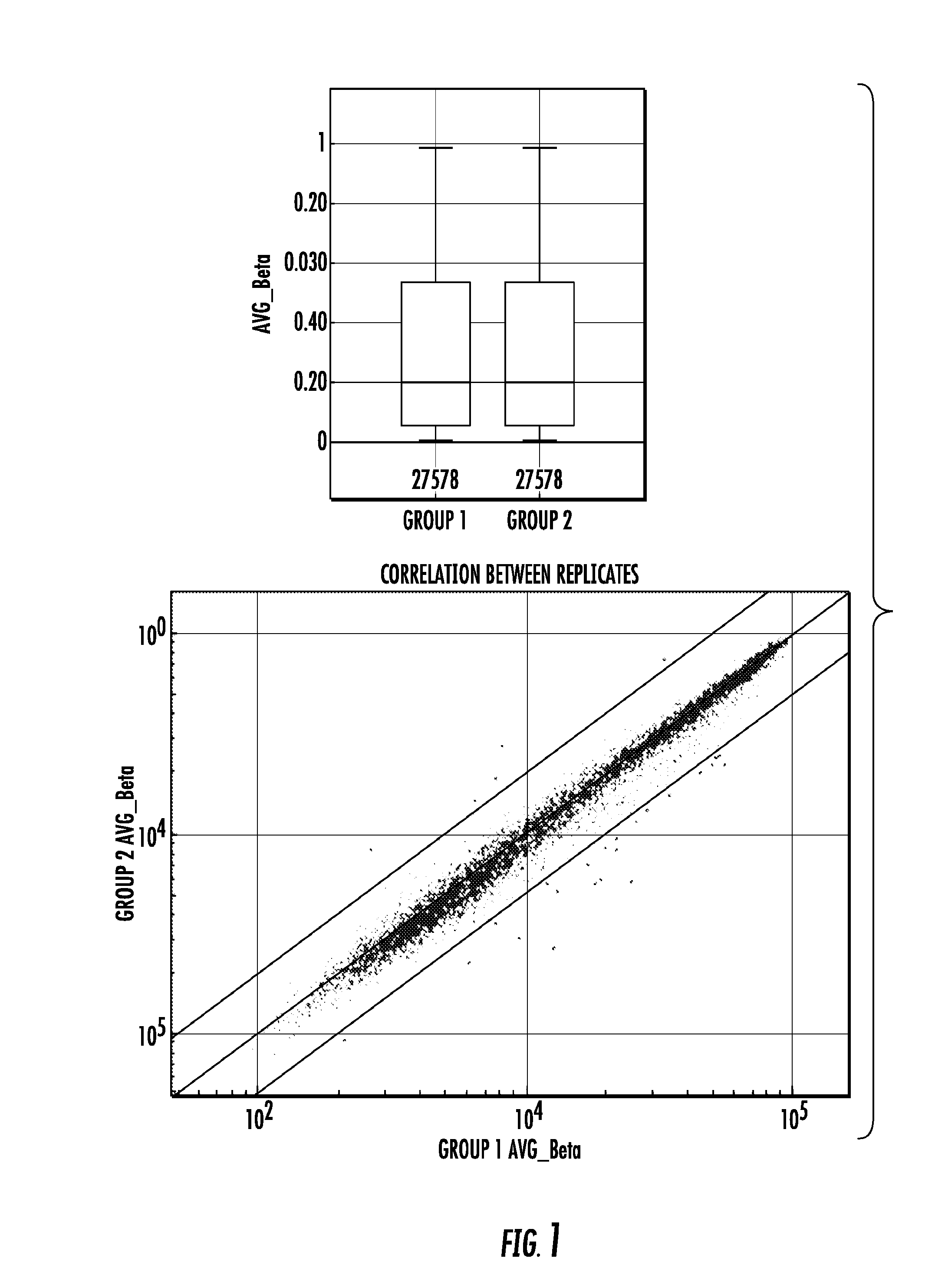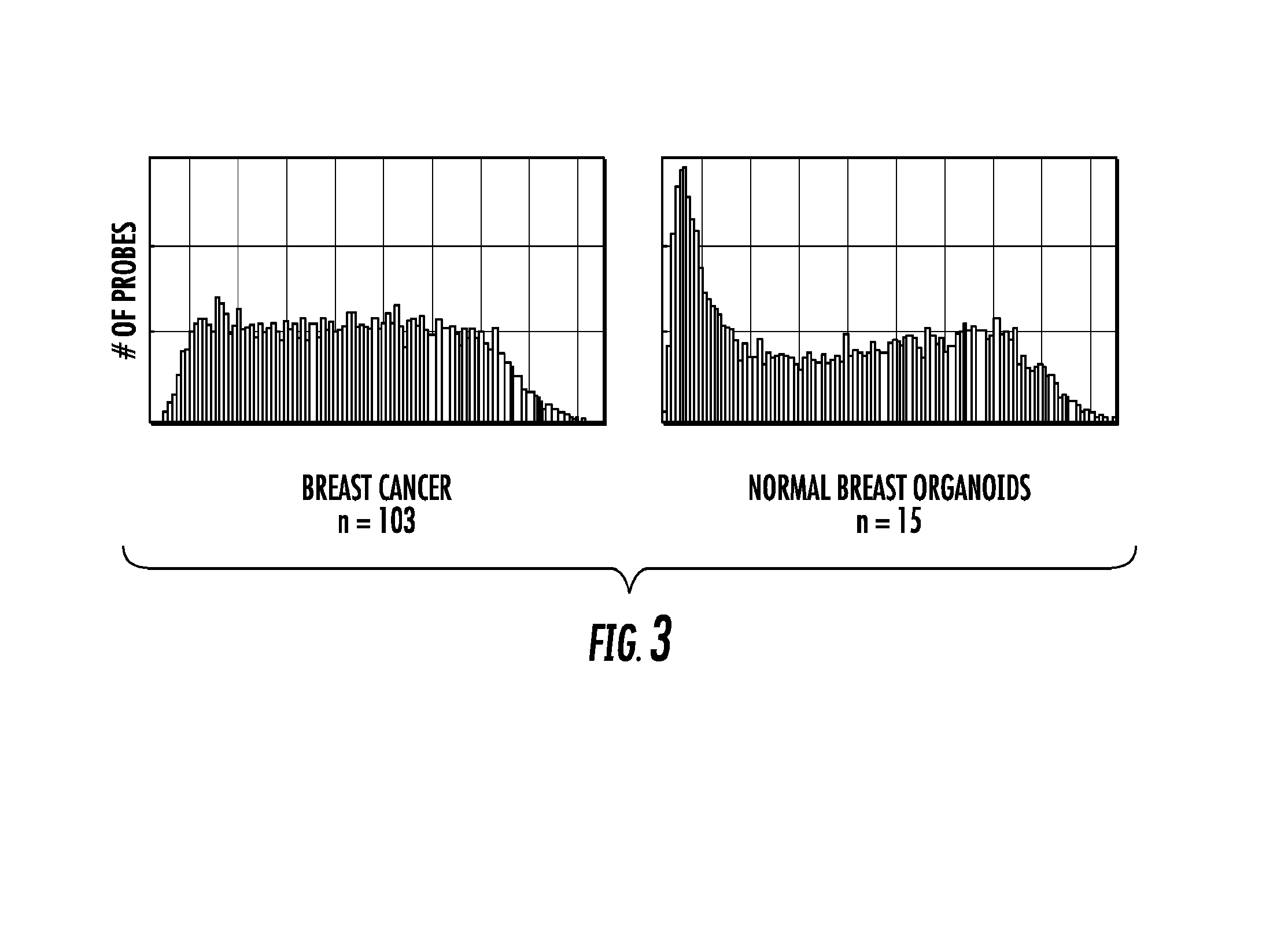Genome-wide methylation analysis and use to identify genes specific to breast cancer hormone receptor status and risk of recurrance
a breast cancer hormone receptor and gene expression analysis technology, applied in the field of genome-wide methylation analysis and use to identify genes specific to breast cancer hormone receptor status and risk of recurrence, can solve the problems of limited or no use of existing markers routinely used in clinical practice in er patients, and the use of commonly used gene expression tests by rt-pcr has no clear prognostic/predictive utility
- Summary
- Abstract
- Description
- Claims
- Application Information
AI Technical Summary
Benefits of technology
Problems solved by technology
Method used
Image
Examples
example 1
[0087]Methylation Profiling of Primary Invasive Breast Cancer Tumors. Whole-genome methylation array analysis was performed using the Illumina Infinium HumanMethylation27 BeadChip with primary invasive carcinoma samples (n=103), samples from microdissected normal breast tissue distant from the primary tumor (n=6), and epithelium enriched organoids isolated from normal breast (n=15). The array quantifies the proportion of methylated cytosines (5mC) to total cytosines at each of 27,578 different CpG dinucleotides. The steps followed for the analysis is shown as a flowchart in FIG. 2.
[0088]To characterize the overall methylation profile of primary invasive breast tumors, unsupervised hierarchical cluster analysis using the Manhattan distance was performed on the most varied probes across tumors (1378 gene loci, SD>1.60) (FIG. 2A). Two distinct clusters of tumors were observed. Cluster 1 was enriched for ER+ breast cancer (21 / 28; 75%), while Cluster 2 contained 85% of the ER− tumors (41...
example 2
[0089]Distinct groups of genes are specifically and recriprocally hypermethylated in ER+ versus ER− breast cancer.
[0090]Very little is known about the genomic features within each ER subtype of breast cancer that could explain why some patients have a good outcome while others will do poorly regardless of treatment. To determine the differences in breast cancer biology / behavior between ER subtypes, methylation patterns were characterized at 8376 selected CpG loci according to ER status. These loci met two criteria: 1) showed the most variation across primary tumors (SD >0.100) and 2) had probe detection p-values <0.0001 (indicating that DNA from that locus was present above background levels and that probe intensities were consistently measured across replicate beads; the distribution of methylation among these loci is shown in FIG. 3). A substantial number of loci were observed with median methylation levels ≧0.15 in both groups of tumor and normal breast organoids. However, the ma...
example 3
[0094]External validation of methylation array findings in an independent test set of primary tumors. The findings of the present invention were validated in publicly available data on the breast cancer samples in TCGA (tcga-data.nci.nih.gov / ) using an ROC analysis to evaluate predictive ability. The median area under the ROC curve for the 200 loci was 0.7; and one gene, SERPINA12, had an AUC of 0.95. In all, 156 / 200 ER probes yielded AUCs higher than 0.563, a range in which we expect only 5% of CpG loci by chance alone. Interestingly, expression of most of these same genes is also a very strong predictor of ER status. It was found that 121 of the 175 unique genes from the ER panel of the present invention and available on the expression array had areas under the curve exceeding the same 5% threshold. This is consistent with the high degree of correlation observed between expression and methylation measurements of these genes in the TCGA data. At an FDR of 0.05, 142 of 200 CpG loci ...
PUM
| Property | Measurement | Unit |
|---|---|---|
| temperatures | aaaaa | aaaaa |
| volume | aaaaa | aaaaa |
| volume | aaaaa | aaaaa |
Abstract
Description
Claims
Application Information
 Login to View More
Login to View More - R&D
- Intellectual Property
- Life Sciences
- Materials
- Tech Scout
- Unparalleled Data Quality
- Higher Quality Content
- 60% Fewer Hallucinations
Browse by: Latest US Patents, China's latest patents, Technical Efficacy Thesaurus, Application Domain, Technology Topic, Popular Technical Reports.
© 2025 PatSnap. All rights reserved.Legal|Privacy policy|Modern Slavery Act Transparency Statement|Sitemap|About US| Contact US: help@patsnap.com



